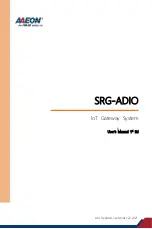
Reference Guide
53
Modem initialization strings
BREAK
The special reply string of BREAK will cause a break condition to be sent. The
break is a special signal on the transmitter. The break sequence can be
embedded into the send string using the \K sequence.
Escape sequences
The expect and reply strings may contain escape sequences. All of the sequences are
legal in the reply string. Many are legal in the expect sequence. Those that are not
valid in the expect sequence are so indicated.
"" or ‘ ‘
Expect or send a null string. If you send a null string, it will still send the
return character. This sequence can either be a pair of apostrophes or quotes.
\b
Backspace.
\c
Suppress the new line at the end of the reply string. This is the only method to
send a string without a trailing return character. It must be at the end of the
send string. For example, the sequence hello\c will simply send the characters
h, e, l, l, o (not valid in expect).
\d
Delay for 1 second (not valid in expect).
\K
Insert a BREAK (not valid in expect).
\n
Send a newline or linefeed character.
\N
Send a null character. The same sequence can be represented by \0 (not valid
in expect).
\p
Pause for a fraction of a second. The delay is 1/10th of a second (not valid in
expect).
\q
Suppress writing the string to the logging system. The string ?????? is written
to the log in its place (not valid in expect).
\r
Send or expect a carriage return.
\s
A space character in the string. This can be used when it is not desirable to
quote the strings that contains spaces. For example, the sequence 'HI TIM' and
HI\sTIM are the same.
Summary of Contents for Firebox X20E
Page 1: ...WatchGuard Firebox System Reference Guide Firebox System 4 6...
Page 12: ...Standard ports and random ports 8...
Page 32: ...Well known services list 28...
Page 36: ...Searching for Blocked Sites 32...
Page 42: ...Newsgroups 38...
Page 50: ...Managing flash disk memory 46...
















































